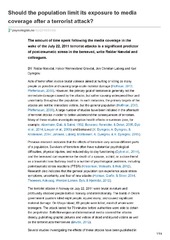Should the population limit its exposure to media coverage after a terrorist attack?
Peer reviewed, Journal article
Published version

Åpne
Permanent lenke
https://hdl.handle.net/1956/17122Utgivelsesdato
2016Metadata
Vis full innførselSamlinger
Originalversjon
https://doi.org/10.15714/scandpsychol.3.e6Sammendrag
This study investigates the relationship between media exposure to the terrorist attacks in Norway on July 22, 2011 and post-traumatic stress reactions (PTSR) three years after the attacks. The sample consisted of two groups of parents not present during the attacks. The bereaved parents lost a child during the attacks, while the control group was selected from the general Norwegian population and did not lose a close relation during the attacks. The results showed that the bereaved parents reported a significantly higher amount of PTSR and media exposure than the control group. Furthermore, the amount of media exposure was found to be a significant predictor for the level of PTSR in both groups combined as well as in the group of bereaved parents alone. It was not a significant predictor in the control group alone. In spite of this tendency, we found no interaction-effect between the trauma of losing a child and media exposure that could account for the level of PTSR. In line with these results, we recommend that people who have lost a close relation in a public event limit their exposure to media following the event. However, we have no empirical foundation for extending this recommendation to members of the general public.